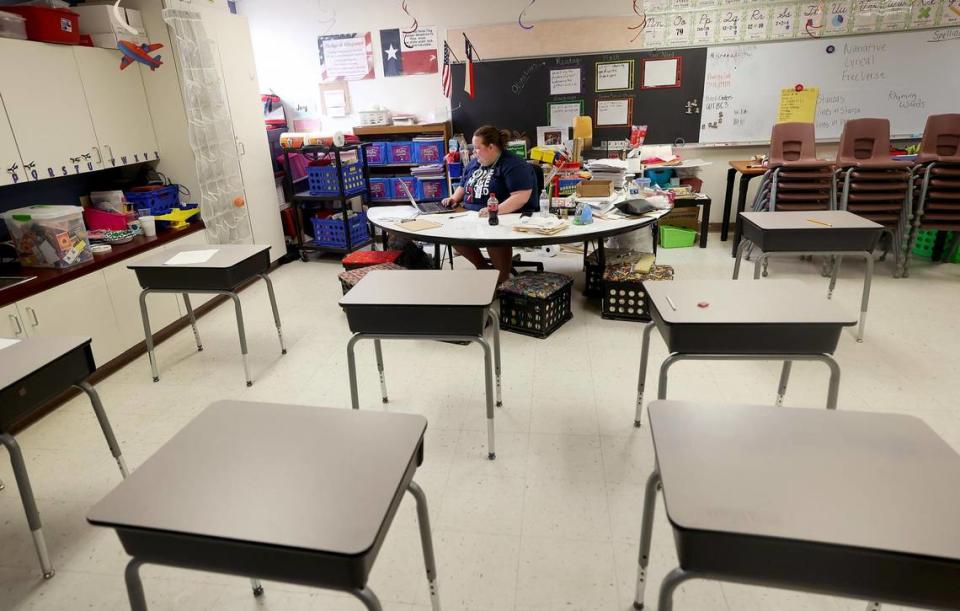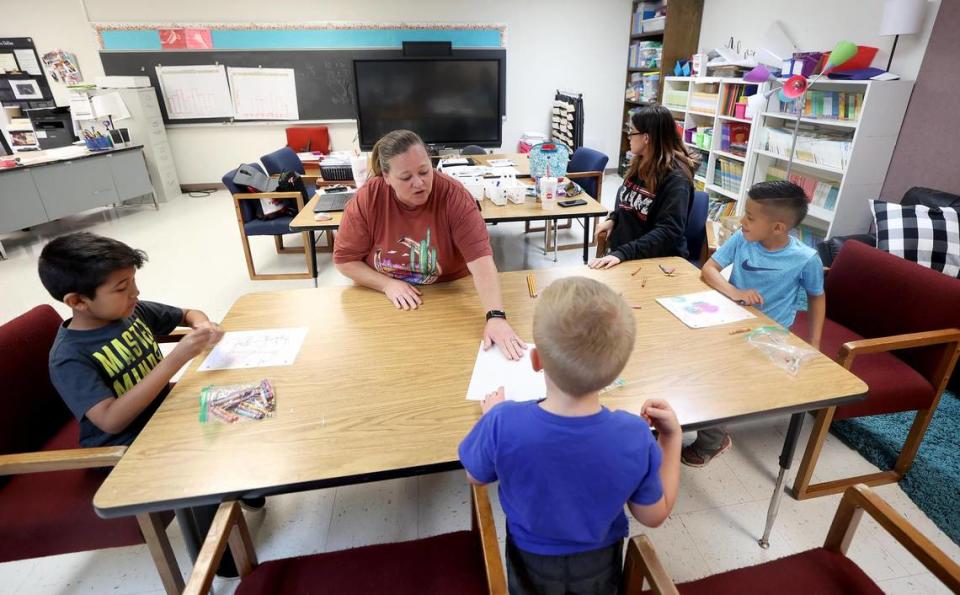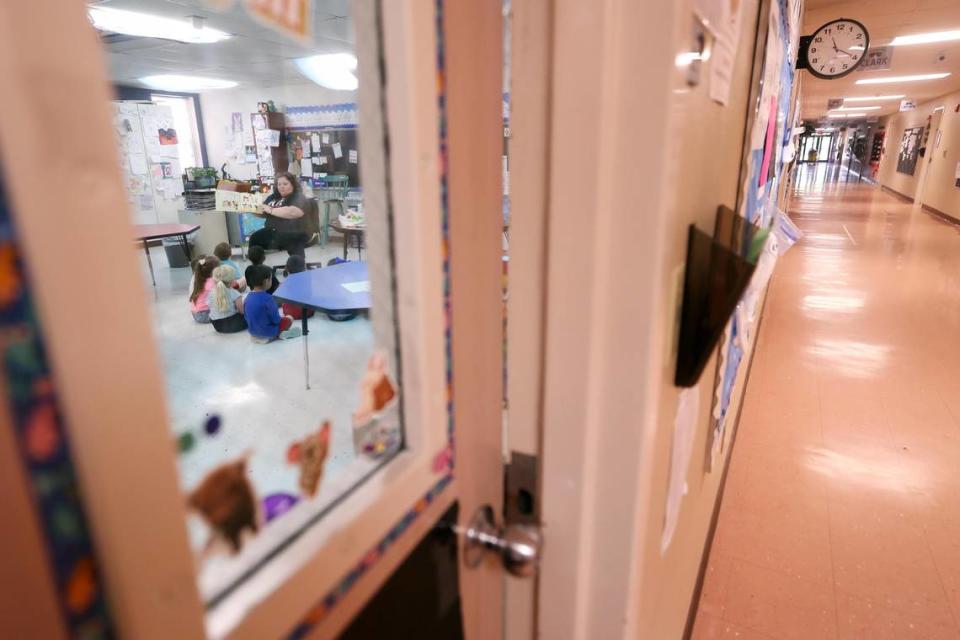Mineral Wells ISD has a 4-day school week. A new Texas Senate bill would make that illegal
A little before noon on a recent Friday, Sadie Roach was in the batting cages at Mineral Wells High School, hitting softballs off a tee.
At the same time last year, Roach, now a high school junior, would have been in class. But for students in the Mineral Wells Independent School District, the weekend now begins when school lets out on Thursday afternoon.
At the beginning of the current school year, Mineral Wells ISD became one of dozens of districts across the state to adopt a four-day school calendar. Now, most students only come to school Monday through Thursday. Teachers use the extra day to catch up on tasks that they struggle to keep up with during the school day, like making lesson plans and grading papers.

The four-day school week is a model many other districts in the state, including several in North Texas, are either adopting or considering, often in an effort to attract applicants for teaching jobs amid a shortage of certified educators. The model was one of several options members of the Governor’s Teacher Vacancy Task Force studied as a possible way to improve working conditions for teachers.
But a bill in the Texas Senate would bar school districts from adopting anything other than a five-day school week. The bill’s author says the change to a four-day week has caused unintended hardships for families with young children in districts that have made the switch.
Mineral Wells student says long weekend means time to catch up
Roach plays volleyball and softball. She’s also active in FFA. Before the change, those three activities combined meant she missed school on several Fridays per year, she said. Now that the entire district is off on Fridays, she misses less class, she said.
At first, the four-day week was hard to adjust to, she said. But she quickly realized it gave her more time to work on her swing in softball or put in some extra reps in volleyball. It also allows her to pick up a few extra hours working at the Crazy Water Hotel, the town’s top landmark.

Having Friday off also gives her a chance to catch up on homework or make up tests she missed, she said. Earlier in the year, she also came to school on a Friday for an SAT boot camp, she said.
Although she likes the change, Roach said she’s noticed that the content of her classes sometimes has to be condensed into a shortened week. For example, her anatomy class recently dissected pigs, which took the entire week. A year ago, the class would have had five days for that project. This year, they only had four, she said.
Texas bill could ban four-day school weeks
Since 2015, state law has dictated the number of hours of instructional time that school districts are required to provide each year, but left it up to districts to decide how those hours would be distributed. That allowed districts to shift to four-day school weeks, making up the extra time by extending the school day, adding days to the calendar or some combination of the two.
A bill in the Texas Senate would bring back requirements governing how many instructional days school districts are required to include in their calendars, effectively requiring them to implement five-day school weeks. Senate Bill 2368 remains pending in the Senate Education Committee following an April 15 hearing.
During the hearing, Sen. Donna Campbell, R-New Braunfels, said the shift to a four-day school week has created unintended hardships for families who struggled to find childcare one day a week and has negative effects on student performance. Campbell said she was especially concerned about the impact of a four-day school week on students who receive special education services, and those who rely on schools for meals.

Jeannie Stone, the former superintendent of the Richardson Independent School District, said during testimony that she was concerned about the growing number of districts that are adopting a four-day calendar. Stone, who now serves as superintendent-in-residence for the Dallas-based Commit Partnership, cited research released in 2022 suggesting that the shortened school week can lead to poorer student performance in reading and math.
Stone said she understands why teachers and parents would find the idea of a shorter school week appealing. But at a time when districts nationwide are still trying to help students recover from academic losses associated with the pandemic, Stone argued that state education officials should be wary of any change that puts student learning at risk.
Research shows four-day week works better in rural districts
Emily Morton, a research scientist with the testing firm NWEA, led the study Stone cited during the Senate committee hearing. Morton and two other researchers examined how a four-day school week affected student performance in districts in Colorado, Iowa, Kansas, Montana, North Dakota and Wyoming. Researchers found that the four-day model could hurt students academically — but it matters where those students are.
On average, Morton said she found “small and medium negative effects” associated with the move to a four-day school week. But those effects have been almost completely concentrated in districts in small towns and suburban areas, according to the paper. The four-day school week is essentially non-existent in urban districts, Morton said.
But in rural districts that made the change, researchers found that students performed, on average, roughly as well as those in similar districts with a five-day school week, and both groups made about the same amount of progress on state tests every year.
Extracurricular activities could be a key factor in explaining the difference in outcomes, Morton said. In rural districts, students often have to travel farther to participate in activities like 4-H or FFA competitions or sporting events. A larger percentage of students in smaller schools tend to be involved in those kinds of activities, she said, meaning a large share of those schools’ students often need to leave early on Fridays.
Those absences are generally counted as excused, but they still mean those students miss instructional time, Morton said. Teachers in smaller schools also told researchers that they often didn’t do any instruction on Friday afternoons, because it didn’t make sense to do so with only a handful of students in class, she said. But when rural districts switched to a four-day calendar, it allowed those students to travel to competitions on Fridays without missing school, she said, meaning they got more instruction from their teachers.

Switching to a four-day school week could also make rural districts, who often have a hard time recruiting enough teachers to fill their classrooms, a more attractive option for educators looking to find a job, Morton said. Although she doubts the change would result in large numbers of teachers from urban districts moving to rural areas, the change could help those districts attract candidates from other rural schools nearby, and also make them more attractive to recent retirees who would consider going back into the classroom for a shortened school week, she said. Having more experienced educators in the district could help mitigate some of the possible negative effects of a shortened school week, Morton said.
In the study, researchers wrote that they found evidence that the negative academic effects of a four-day school week might grow over time both in rural and non-rural districts, reaching “medium” size three years after the policy was adopted.
Morton said it’s also important to remember that, while the change might be a net positive for some districts, it can be hard for students who don’t have a safe environment at home or access to nutritious food outside of school.
“If we think about some of the students on the margin and how they might be impacted by this, the policy might be especially devastating for a small subset of kids,” she said. “And I’m worried that they’re sometimes left behind in the average numbers.”
Mineral Wells ISD kids get extra help on Fridays
It’s too early to say how the shift to a four-day calendar will affect how Mineral Wells students perform on state tests — and this year’s test results will come with big caveats, because of changes in the test format and the way students take it. But John Kuhn, superintendent of Mineral Wells ISD, said the district’s interim assessments indicate students are doing about as well academically as they did last year, under a five-day week.
Not having school on Fridays has allowed the district to offer extra help to students who need it, he said. The district set aside four Fridays for accelerated instruction, designed to help students make up ground they lost due to the pandemic, he said. That designated time means students who are struggling get more one-on-one attention from teachers, and it also helps the district comply with state tutoring requirements, he said.

School officials anticipated the calendar change might cause child care issues for parents of some of its younger students. So when the district rolled out the shortened school week last August, it also offered a catch-up day on Fridays for students who needed extra help, or for parents who needed a place to send their kids while they’re at work. The program is open to students up to fourth grade.
About 30 kids are signed up to go to school on Fridays, Kuhn said — less than 1% of the roughly 3,300 students enrolled in the district. School leaders have taken that low turnout as an indication that child care wasn’t a problem for most families in the district, he said.
Students who come to the Friday program get a mix of academics and enrichment activities throughout the day. On the morning of April 14, 31 students were at Houston Elementary School, the site where the district hosts the program. Pre-kindergartners and kindergartners worked on math worksheets, first-graders used a math intervention program on tablets and older kids kicked soccer balls around in the school gymnasium. In the afternoon, students would rotate through other activities like art and hands-on STEM projects, said principal Jacy Roach.

Roach, who is Sadie Roach’s mom, said the shift to a four-day school week has meant teachers in her building have to be “laser focused” on student learning. Now that teachers have fewer days per week with students, they need to be more conscientious about making that time count, she said. While teachers are with their students, they spend every minute doing instruction, she said, whether it’s working with the entire class at once, with small groups or with individual students.
Roach said she understands that some lawmakers might be concerned about how the change affects student learning. But she encourages them to come to Mineral Wells, walk school hallways and see the results. Her students don’t seem to have suffered academically, she said, and she thinks it’s given students and teachers a boost they’ve needed for a while.
“After COVID, we just needed a reboot,” Roach said.
Four-day week helps small districts recruit teachers, superintendent says
During a May 5 Senate hearing, Darol Hail, superintendent of the New Waverly Independent School District, said the issue of extracurricular activities was a big part of why the district decided to move to a four-day schedule. New Waverly is a rural district about an hour’s drive north of Houston. The district will switch to a four-day calendar at the beginning of the next school year.
The district’s small size means that most students are involved in a number of extracurricular activities, Hail said. When the district surveyed students, officials found that about 70% of students grades 6-12 were involved in at least one activity, and most were involved in many, he said.
“If I have a student who’s involved in ag, softball or baseball and basketball, they have the potential of missing nine Fridays just for extracurricular activities alone, before they’ve even caught a cold,” he said.

Recruiting quality teachers has always been a challenge for New Waverly, Hail said. The district offers the best teacher salaries it can afford, but other districts nearby offer starting salaries that nearly match what New Waverly pays 25-year veterans, he said.
Although the district hasn’t even made the switch to a four-day calendar, the decision to do so is already paying dividends, Hail said. In years past, the district often left positions vacant at the beginning of the year because no one applied for them, or else officials were forced to hire the one person who applied, regardless of how good a fit they were, he said. This year, the district has received applications for every open position.
“I’m getting applications for positions I haven’t posted yet,” Hall said.
Four-day schedule came with learning curve
A little before noon on a Friday last month, Lena Crusha, a third-grade teacher at Houston Elementary, was in her classroom catching up on grading. She expected she would probably work until about 1 p.m., then go home and start her weekend with her family.
Before the change, Crusha would have had to come to school on a Saturday or Sunday to take care of jobs she couldn’t find time to do during the week. Sometimes on a Saturday night, she’d be at school until well after midnight getting things ready for the following week, she said. Then she’d be back at school on Sunday to print out worksheets, leaving her barely any time to spend with her family.
The change hasn’t been without its challenges, Crusha said. Every teacher in the district had to figure out how to condense five days worth of material into a four-day week, she said. For her, that’s meant trimming out as much unproductive time as possible and making every minute of class time count.
“It was… a learning curve at first,” Crusha said. “But now, I don’t know if I’d want to go back to five days.”

